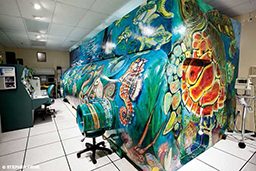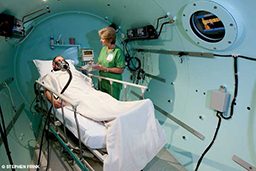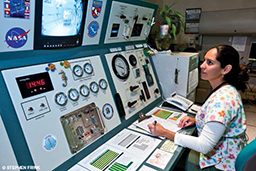For divers suffering decompression illness (DCI), the immediate availability of hyperbaric oxygen therapy (HBOT) is imperative. It has frequently proved to be lifesaving. It has resolved paralysis and overcome other forms of damage to the brain and spinal cord. Just as frequently, it has eliminated painful musculoskeletal injuries. Of equal importance to many is that prompt hyperbaric treatment frequently means the difference between being able to return to diving versus being declared medically and perhaps permanently unfit to do so. For certain medical patients, HBOT is likewise sparing of life and central nervous system. It optimizes management of gas gangrene, enhances skin flap survival and reduces the rate of amputations in trauma victims and people with diabetes.
Sadly, for divers injured in the U.S. and patients with the medical conditions listed, there is much to be concerned about. The harsh reality is that the percentage of hyperbaric medicine programs introduced during the last decade that are available on a 24/7 basis to treat divers and these other emergent conditions has collapsed into single digits at best. This contrasts sharply with the prior decade, in which a majority of new programs were available 24/7; this availability was an almost universal standard in previous years. Adding to this conundrum is a growing trend among established facilities to discontinue their existing 24/7 coverage. This trend has increased in the past 24 months, and the rate at which access is lost continues to accelerate.
Before we examine the history that led to this state of affairs or attempt to identify possible solutions, it may be useful to put the crisis into a human context using several recent case examples. Some are tragic, and all were essentially avoidable.
Case Studies

A retired nurse suffered decompression-induced cerebral arterial gas embolism (AGE) while diving off Florida’s east coast. She was urgently evacuated from the scene to a nearby hospital, one that offered HBOT and had been actively promoting its presence in the community. Consistent with many other recreational diving accidents, this one occurred on a weekend. Emergency-department (ED) personnel unsuccessfully attempted to summon their hyperbaric medicine colleagues. The ED was eventually advised that the hyperbaric service was only available during business hours on weekdays. Furthermore, and by design, they would not offer care to injured divers even if they presented during normal working hours. Following what were described as desperate attempts to locate a hospital that would accept and treat this patient, contact was established with DAN®, which was able to identify an available hospital in south Miami. After being supported for several hours in the ED, the patient was duly transferred. HBOT began soon upon her arrival at the receiving hospital. Unfortunately, she died during her initial hyperbaric treatment.
A middle-aged male patient underwent heart surgery to remove a tumor. During surgery there was inadvertent introduction of a considerable amount of air into his brain’s arterial circulation, causing AGE. This is essentially the same problem that can be experienced by divers who hold their breath during ascent. Immediate, severe neurological collapse occurred. This event also took place on a Saturday in a large city in Georgia that is home to some 12 hyperbaric medicine facilities. None would accept the patient. Eventually, a hospital in an adjacent state agreed to accept him. Following a determination of the risks and benefits associated with a somewhat lengthy transfer of this recent heart-surgery patient, the transfer was conducted. Unfortunately, and despite an aggressive course of HBOT, the patient failed to improve to any measurable degree. He was committed to long-term supportive care. Treatment delay was a likely contributing factor to this poor outcome.
A recreational scuba diver suffered decompression sickness (DCS) following ascent from a freshwater lake in central Florida. It was a weekday, so the odds of available hyperbaric oxygen therapy would appear more favorable, particularly as a nearby major medical center had been treating injured divers for several decades. Due to budgetary issues, however, this hospital had reduced the number of days per week that the hyperbaric medicine service would be on call. Tuesday was one of the noncall days. This diver, therefore, had experienced a double misfortune. Not only had he suffered DCS, he had done so on a Tuesday. Unfortunately, the reduced availability of this service had not been widely communicated, particularly to those in a position to refer emergent cases or effect their transfers. After some delay, the diver was eventually transferred elsewhere in the state and was fortunate to experience complete clinical resolution of his symptoms.
The lone survivor of a coal-mine disaster was rescued after being trapped underground for several days. He was comatose at the time of his rescue and urgently transferred to a nearby medical center in West Virginia. His primary problem was severe carbon-monoxide poisoning. Not having a hyperbaric medicine program, this hospital requested urgent transfer to a nearby hospital that did. Their request was denied on the grounds that the hyperbaric medicine facility was unavailable for emergent cases (it operated as an outpatient wound-care hyperbaric facility). Transfer was arranged some days later to a 24/7 hyperbaric medicine service in a neighboring state. The patient had a protracted hospitalization and incomplete neurological recovery at the time of his discharge.
A History of Hyperbaric Care in the U.S.

To put this serious issue in perspective, one needs to reflect on the evolution of HBOT. Early hyperbaric chambers were not hospital-based. Rather, they could be found at various industrial and commercial worksites. These chambers served in support of civil-engineering projects such as bridges and tunnels constructed above and beneath various bodies of water. Underground mass-transit systems were another common worksite in which a chamber might be present. Caisson workers employed in these projects would enter chambers to decompress from their pressurized work environments. They would return to the chambers to be recompressed (treated) should their decompression schedules prove incompletely protective. By the 1950s a growing number of military diving operations were also supported by onsite recompression chambers.
It was not until the early 1960s that hyperbaric chambers found their way into the hospital setting. During this period several newly identified therapeutic mechanisms were associated with hyperbaric doses of oxygen. These mechanisms served to extend hyperbaric medicine’s use beyond the treatment of DCI. Patients hospitalized with acute traumatic crush injuries, carbon-monoxide poisoning or gas gangrene were now considered referable to hyperbaric medicine. The ensuing years were characterized by a steady growth in the geographic availability of hospital-based hyperbaric chambers and the number of treatable conditions. At this point, essentially every hyperbaric medicine program was organized and staffed to provide 24/7 care, such was the nature of the majority of its common uses.
A New Business Model
By the late 1980s, utilization of the hyperbaric chamber for wound-healing deficiencies was becoming commonplace. As most of these wounds were chronic, patients were not usually hospitalized. Rather, they traveled to and from the hospital for daily treatments. During the mid-1990s a unique business model was created, one that combined hyperbaric medicine and wound-healing services. This model blossomed to the extent that the great majority of subsequent hyperbaric medicine programs have been organized and operated in this manner.

The model’s concept was not to provide hyperbaric medicine for the full range of accepted uses. Rather, access was limited to outpatients, essentially those suffering deficient wound healing. And it was only available during normal business hours; extending the availability of hyperbaric medicine to accommodate emergencies would increase equipment expenses. It would also substantially raise personnel costs due to 24/7 on-call coverage and the professional staff necessary to effectively manage these more medically challenging patients. All this extra expense would occur with little commensurate increase in revenue, thereby negatively affecting the profitability of a business model established as a revenue-generating venture. Certainly, the prevalence of this model has improved access to HBOT for those with chronic wounds, but it has done so while creating a significant downside: reduced access to care for divers and other people with emergent medical needs.
Under this business model, hyperbaric chambers are commonly located on a hospital’s campus but often not within the hospital itself. Adjacent medical office buildings represent the usual location. This makes it all but impossible for those patients hospitalized or in the ED (and, one could argue, likely to benefit most from HBOT) to gain necessary access. Outpatient-only hyperbaric programs further distance themselves from the management of emergent and typically sicker patients by not incorporating otherwise standard biomedical monitoring and ancillary support equipment. This includes infusion pumps, electrocardiogram (ECG) and invasive pressure monitors, through-hull tissue-oxygen monitoring cables, hyperbaric ventilators and more. Treatment pressures are frequently standardized at 2 ATA (33 feet) for all patients. This is incorrectly assumed to eliminate any likelihood of seizures due to central nervous system oxygen toxicity and therefore eliminate the need for air-break delivery systems. Air breaks are vital for the treatment of DCI and certain other emergent conditions.
As the regional availability of this normal-business-hours-only model rapidly expanded, hospitals providing 24/7 hyperbaric medicine soon began to feel an economic pinch. Competing outpatient-only programs, by design, sought the more stable, less clinically challenging and typically better-insured patients. Costs required to maintain 24/7 capabilities continue to increase while revenues generated trend down. Thus, a growing number of hospitals have reconsidered their 24/7-coverage position.
Sadly, and all too frequently, the cost argument is winning out over the best-medical-practice argument. Consequently, a growing number of hospitals have elected to discontinue on-call availability; others have decided to close their hyperbaric-medicine service altogether. The predictable net effect is a significant national decline in the resources necessary to provide and maintain this vital standard of care. Very few new programs are prepared to accept the 24/7 responsibility, and long-established programs continue to opt out. Divers and others for which the immediate provision of HBOT can make the difference between a good outcome and a bad one are increasingly being denied necessary and timely access.
A Way Out
In general, the diagnosis and treatment of a broad range of difficult-to-manage conditions has greatly improved over the past decade, as has patient access to such care. During this same period, however, the ability to refer patients to hyperbaric facilities with conditions considered appropriate by both the mainstream medical community and by those who underwrite its costs is becoming increasingly difficult.
What solutions exist that might serve to reverse this trend, and how can individuals for whom the early provision of HBOT is vital obtain necessary access? As the principal issue is financial, some possible solutions might include the following:
- The rates insurance companies pay to chamber facilities for HBOT are increased for those treatments initiated outside of normal business hours.
- Insurance company payment rates to chamber facilities for all HBOT are increased for those hospitals that maintain 24/7 emergency availability.
- Insurance company payment rates are decreased to providers of HBOT that do not offer 24/7 access. This could be worked out to become cost neutral for those paying for care as these savings could be used to pay additional fees to the 24/7-available facilities.
- A network of hyperbaric medicine facilities is developed to offer 24/7 call response; perhaps some of the necessary funding support can be provided by hyperbaric facilities that choose not to be so available.
- Insurance companies could expect those facilities that file claims for providing HBOT to be willing and available to provide such therapy for all the conditions the insurance companies consider medically necessary.
In the meantime this difficult situation will remain. For those who plan to travel overseas to dive, the news is much better. The business model described is limited to the U.S., where medical services are often provided or managed by third-party for-profit organizations such as venture capitalists, investment houses and commercial banks. Essentially all international hyperbaric chambers remain available to treat divers and other emergent indications for hyperbaric oxygen therapy.
DAN maintains an extensive network of chambers willing and able to treat divers. If you have symptoms after diving, we will help you get the care you need. Call the DAN Emergency Hotline at +1-919-684-9111.
© Alert Diver — Q1 Winter 2012